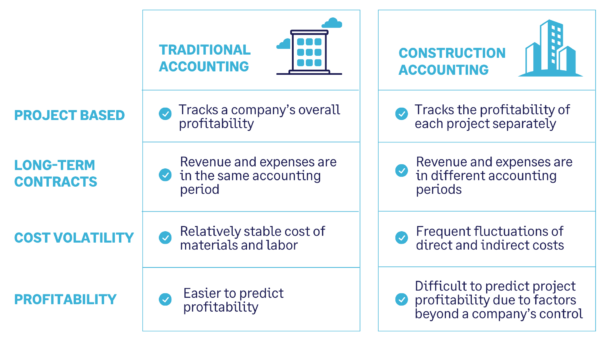Construction Accounting Reports You Need for Successful Decision-Making
Construction Accounting Reports You Need for Successful Decision-Making
Blog Article
Grasping Building And Construction Audit: Important Tips for Financial Success in the Sector
Grasping building accountancy is a critical element for monetary success within the market, as it incorporates numerous techniques that straight influence job profitability. Discovering these ignored techniques might reveal opportunities that could transform your approach to building audit.
Understanding Building And Construction Accounting Fundamentals
Understanding the principles of construction accounting is vital for reliable task administration and economic oversight in the construction market. Building and construction accounting differs significantly from conventional audit methods as a result of the distinct challenges posed by project-based work, including variable costs, rising and fall timelines, and complex governing needs.
An essential aspect of building and construction accounting is work setting you back, which includes tracking expenses for every specific task. This method allows contractors to properly evaluate success and make notified economic decisions. Additionally, construction accounting encompasses making use of progression payment, where billings are provided based upon the percentage of work completed, making certain money circulation is kept throughout the project lifecycle.
An additional important component is the monitoring of adjustment orders, which represent adjustments to the initial agreement range. Appropriate documents and accounting for these adjustments are essential to avoid financial disagreements and make sure precise task budgeting.
Last but not least, understanding the relevance of compliance with industry regulations and tax obligation demands is vital. Precise monetary reporting and adherence to accounting standards not only safeguard versus legal issues but likewise enhance the reliability of building firms. Understanding these essentials sets the structure for effective monetary administration within the building market.
Effective Project Budgeting Strategies
Reliable task budgeting methods are important for guaranteeing that building and construction tasks stay economically sensible and on track. A well-structured spending plan serves as a roadmap, guiding project managers via the intricacies of building prices.
Next, utilizing historical information from previous jobs can dramatically enhance the accuracy of budget plan quotes. By examining previous expenditures, teams can recognize cost trends and prospective risks. Engaging stakeholders during the budgeting procedure promotes openness and secures buy-in, which can reduce conflicts later on.
In enhancement, embracing an in-depth line-item spending plan enables careful tracking of expenses related to products, labor, and overhead. This granularity enables job managers to recognize variations early and readjust techniques appropriately. In addition, incorporating contingency allowances within the budget plan can aid make up unanticipated expenditures, safeguarding the project against monetary stress.
Last but not least, routine spending plan reviews throughout the task lifecycle ensure that monetary purposes continue to be straightened with job goals, helping with timely treatments when necessary. Carrying out these strategies can considerably add to the monetary health and wellness and success of construction projects.
Simplifying Cost Tracking Processes
Accurate price tracking procedures are vital in the building and construction industry, as they often identify the monetary success of a task. Reliable tracking enables project managers to keep an eye on expenses in real-time, guaranteeing they stay within budget and can make enlightened choices quickly. To enhance these procedures, it is crucial to adopt an organized strategy that integrates innovation and well-known procedures.
First, making use of specialized building accounting software application can automate information access and coverage, lessening human error and boosting efficiency. construction accounting. Such software typically includes attributes for tracking labor, materials, and subcontractor costs, supplying an extensive view of project expenses
Second, standardizing treatments for tape-recording costs across jobs boosts uniformity and simplifies evaluation. Establishing a clear chart of accounts customized to the distinct requirements of construction projects can facilitate precise categorization of the original source costs.
Last but not least, regular training for team on the significance of specific expense monitoring and the devices used at the same time promotes responsibility. By applying these techniques, building companies can significantly enhance their expense monitoring processes, bring about enhanced economic control and job earnings. Ultimately, a well-structured method to set you back tracking lays the groundwork for effective project administration and long-lasting monetary sustainability.
Taking Care Of Capital Successfully

Frequently monitoring money flow declarations is vital. By evaluating cash money inflows and discharges, companies can determine patterns and prospective shortages. This method promotes prompt adjustments to costs or settlement schedules, stopping money lacks that can jeopardize project timelines.

Lastly, preserving a financial pillow or credit line can offer a security net during lean durations. Utilizing these methods will certainly result in an extra stable economic foundation, allowing construction firms to navigate the industry's intrinsic unpredictabilities with higher self-confidence.
Staying Clear Of Usual Bookkeeping Challenges
In the complex landscape of building and construction accounting, staying clear of common mistakes is essential for preserving monetary integrity and task success. Building and construction jobs often involve countless deals, and falling short to document them properly can lead to discrepancies and monetary losses.
One more risk is the mismanagement of change orders. Adjustment orders are a natural component of building and construction jobs, yet without proper audit for these modifications, business may have a hard time to redeem prices. Establishing a clear procedure for documenting and authorizing change orders can alleviate this risk.
Additionally, overlooking to reconcile accounts consistently can cause imprecise economic declarations and hinder decision-making. Normal reconciliation guarantees that records straighten with bank declarations and job paperwork.
Finally, neglecting tax obligation commitments can have extreme repercussions. It is essential to stay educated regarding tax obligation regulations specific check my reference to the building sector, including sales tax on products and labor.
Conclusion
Mastering building bookkeeping is important for accomplishing financial success within the market. Prioritizing compliance and addressing common bookkeeping mistakes strengthens reliability and sustains lasting profitability, ultimately cultivating a sustainable affordable benefit in the building industry.
Report this page